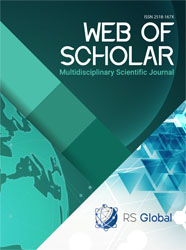ACTUAL ISSUES OF FINANCIAL STABILITY OF THE AGRICULTURAL SECTOR OF UZBEKISTAN
Abstract
This article examines the prospects for increasing the competitiveness of the agro-industrial complex of the Republic of Uzbekistan through the formation and development of clusters as an innovative type of production management, outlines the main problems and the current state of the domestic agro-industrial sector, which forms national food security, directions and mechanism for the development of factors aimed at creating conditions for sustainable growth of the country's economy. At present, characterized by the global trend of growing global competition, the problem of finding new factors that can ensure the growth of national competitiveness and sustainable development of the state’s economy arises, and this makes this article relevant.
One of the means of updating the production management system to solve this problem is the cluster approach, which can be effectively implemented, when will be taken into account the specific conditions of certain areas of economic activity.
References
Aker, J. C. (2011), Dial “A” for agriculture: a review of information and communication technologies for agricultural extension in developing countries. Agricultural Economics, 42: 631–647. USA
Anaeto F.C., Asiabaka C.C., Nnadi F.N, Ajaero J.O., Ugwoke F.O., Ukpongson M.U &Onweagba, A.E. (2012). The role of extension officers and extension services in the development of agriculture in Nigeria. Wudpecker, Journal of Agriculture Research, 1(6):180-185. Nigeria.
Archer, N. P., Ghasemzadeh, F., Brooking, A., Board, P., Jones, S. (1998). The Predictive Potential of Intellectual Capital, Volume 16, Issue 1-3.
Баутин В.М. Понятие “инновация” как экономическая категория // Развитие инновационной деятельности в АПК: Материалы международной научно-практической конференции. – М.: ФГНУ «Росинформагротех». 2003. – 251-253 с.
Baller. S., Dutta S., & Lanvin,B. [Eds].(2017).The Global Information Technology Report 2016: Innovating in the Digital Economy: Geneva: World Economic Forum, 307 p.
Birner R, Davis K, Pender J, Nikoniya E, Anandajayasekeram P, Ekboir J, Mbabu A, Spielman D, Benin S. (2006). From best practice to best fit: A framework for analyzing agricultural advisory services wordwide. Development Strategy and Governance Division, Discussion p.39, IFPRI, Washington, DC.
Birner R, Anderson О (2007). How to make agricultural extension demand driven? The case of India’s agricultural extension policy. IFPRI Discussion Paper 00729, Development Strategy and Governance Division, IFPRI, Washington, DC.
Knickel, K., Brunori, G., Rand, S., &Proost, J. (2009). Towards a better conceptual framework for innovation processes in agriculture and rural development: From linear models to systemic approaches. The Journal of Agricultural Education and Extension, 15, 131–146
Knierim, A., Labarthe, P., Laurent, C., Prager, K., Kania, J., Madureira, L., &Ndah, T. H. (2017). Pluralism of agricultural advisory service providers–Facts and insights from Europe. Journal of RuralStudies, 55, 45-58.
Kaplan, R. S., Norton, D. P. (1996). The Balanced Scorecard. Boston: Harvard Business School Press, P. 75–85.
Карташов Е.Ф. Модернизация сельскохозяйственного производства на основе трансфера инновационных технологий. ФГБОУ ВПО «Мордовский государственный университет имени Н.П. Огарева». Научный журнал «Фундаментальные исследования». No9. 2013 г.
Перушкевич И.П. Методические аспекты оценки инновационной активности сельскохозяйственных организаций // Вестник Алтайского государственного аграрного университета. 2013. No 7. С.138-141.
Sveiby, K. E. (1997). The Intangible Assets Monitor. Journal of Human Resource Costing &Accounting, Vol. 2, Issue 1, P. 73–97.
Stewart, T. A. (1998). Intellectual Capital: The New Wealth of Organizations. N.Y.-L.: Doubleday. Currency, 288 p.
Views:
326
Downloads:
178
Copyright (c) 2019 The author

This work is licensed under a Creative Commons Attribution 4.0 International License.
All articles are published in open-access and licensed under a Creative Commons Attribution 4.0 International License (CC BY 4.0). Hence, authors retain copyright to the content of the articles.
CC BY 4.0 License allows content to be copied, adapted, displayed, distributed, re-published or otherwise re-used for any purpose including for adaptation and commercial use provided the content is attributed.











